The sun's rays split the trees as a deer and fawn strolled between headstones in Camelon Cemetery. In the distance, a lone piper's lament could be heard as the crunching of slow-moving tyres on gravel signalled a procession of cars making their way to the crematorium.
Natalie Bushell, a graduate trainee who joined the Council last year, spots an elderly couple lost and unable to find the grave of a loved one. Using a tablet she accesses a digital tool, PlotBox, quickly locating the grave and providing directions to the grateful couple.
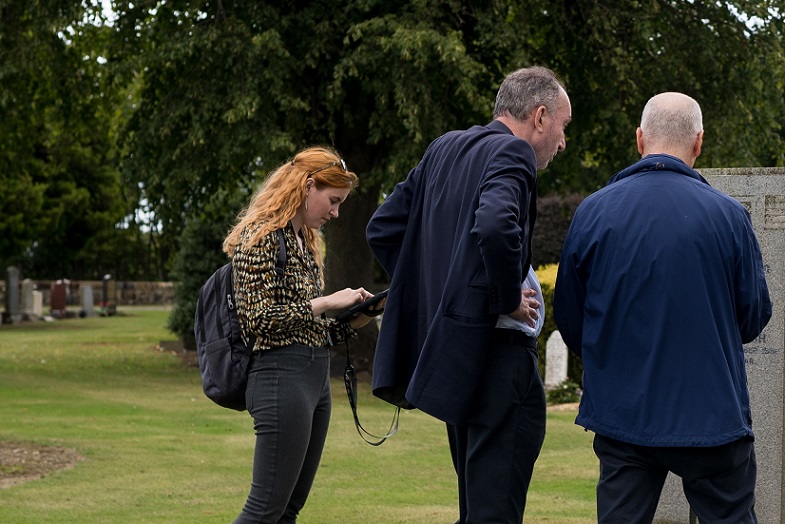
Pictured: Natalie (pictured above) uses her tablet to locate a grave while Kenneth Lawrie (centre) speaks with Allan Ogilvie (right) about the PlotBox work.
All the while Kenneth Lawrie, Chief Executive, listens intently to Ian Edwards, Projects & Development Co-ordinator, Environment & Operations, and Jillian McGrandles, Bereavement Manager.
Having both worked through the pandemic, they tell him of the challenges Bereavement Services faced and how the team banded together to keep the vital service going, their pride almost palpable.
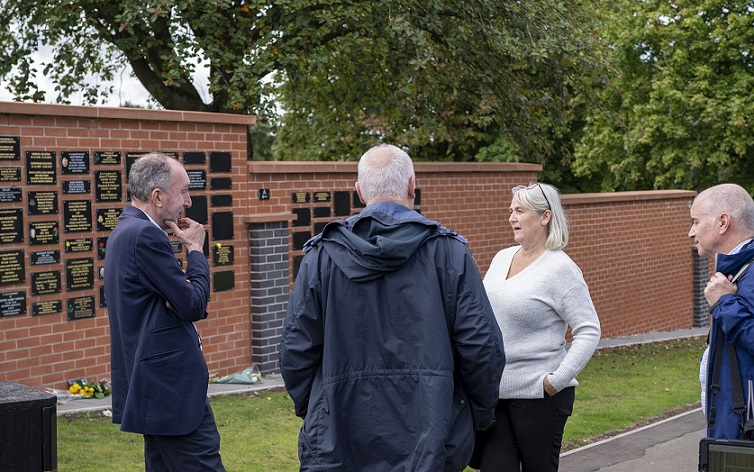
Pictured: Ian Edwards (centre) and Jillian McGrandles (right) explain to Kenneth (left) the difficulties the pandemic brought and how the team continued to deliver services face-to-face.
Like many Council services, the team was put under unimaginable pressure due to COVID-19, adapting and responding to ever-changing Government guidelines while continuing to meet the critical needs of grieving families.
"It was an unbelievably tough time," said Crematorium Manager, Willie Candlish, who has worked at the crematorium for over 30 years. “A lot of the time we were in the dark. We simply did not know what to expect and we had contingency plans in place for the worst-case scenario.”
Gary Shields, Crematorium Technician, added: “The situation we found ourselves in because of COVID was horrific. Families did not get a choice as to when to cremate loved ones as we were operating to such strict guidelines and timeframes.
“Our job can be very emotional. You almost have to disconnect yourself but never get complacent. This is a person's last journey, and we always take great pride in ensuring that it goes smoothly.”
Bereavement Services remit is wide and varied. As well as providing respectful cremations and burials, it introduced a memorial wall earlier this year to provide people with an alternative way to commemorate loved ones.
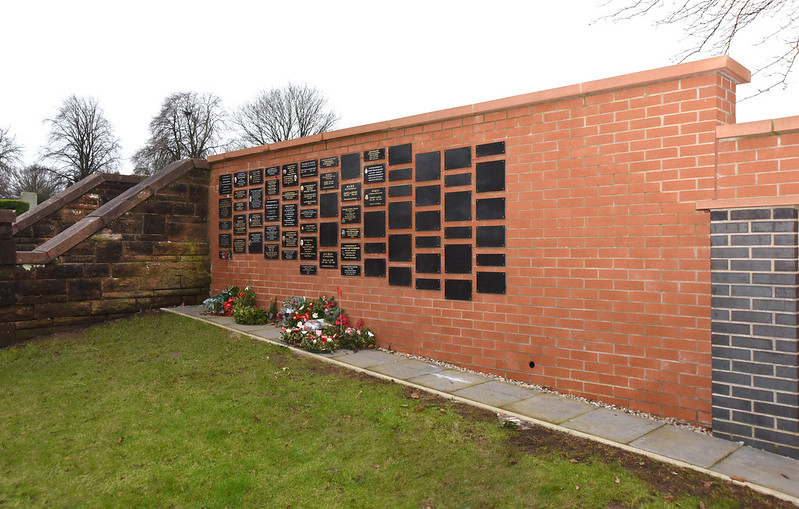
Pictured: The memorial wall offers people the chance to pay tribute to family and friends in a more affordable way.
Safety first
The team also work closely with other services to maintain the Council’s 13 cemeteries. This includes Planning & Greenspace, the service for which our PlotBox experts Allan Ogilvie and Natalie work.
During the pandemic Allan - who had started to map our cemeteries with a GIS app in 2017 - continued to undertake that work, using the app to double check coordinates to ensure precise locations were uploaded to PlotBox.
To date, nearly 29,000 headstones have been added to PlotBox, with 8,000 still to be surveyed.
Introduced as part of a Council of the Future project, PlotBox is a cloud-based cemetery management system that not only reduces paperwork and hours spent filling in forms but also - and most importantly - helps keep our cemeteries safe.
Ian Edwards said: “As a Council, we are responsible for the safety of everyone who visits or works in our cemeteries. Many headstones are unstable and hundreds of years old - the oldest in Camelon dates back to 1870.
“Some years back, I gave a light push to a headstone in Slamannan Cemetery. It was obvious it needed to be secured. My biggest problem at the time was remembering where it was.
“Now, thanks to PlotBox and the hard work of Allan, Natalie and others, we can find individual headstones at the touch of a button. We are also able to digitally record which headstones need repaired and when work is complete."
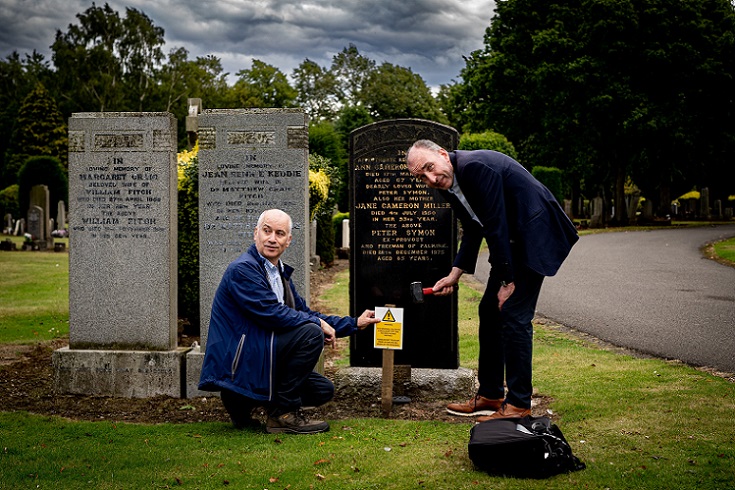
Pictured: Kenneth (right) hammers in a warning sign held by Allan (left) at a headstone in need of repair. A photograph of the headstone is then added to PlotBox, with a further picture uploaded once repairs are complete.
Allan added: "Although it will take a few more years to complete the work, the system has already transformed how we record work, with an added benefit of the tool helping people find loved ones in our cemeteries. In the future, we hope to use the information we’ve uploaded to undertake genealogy work, which would be a new service to offer local people."
Space for all
With new regulations in place, it is now even harder to find land to create or extend a cemetery, making finding space within the grounds we already maintain a priority. Thanks to the mapping work at least 40 potential new plots have been identified in Camelon alone.
“Investing in new technology has helped modernise a large part of what we do, making us more effective and efficient,” said Ian. “It’s also brought unintended benefits like identifying potential new plots. Finding new land for burials is our greatest challenge – and it is a challenge facing almost every country in the world, as space to lay the dead to rest is at a premium.”
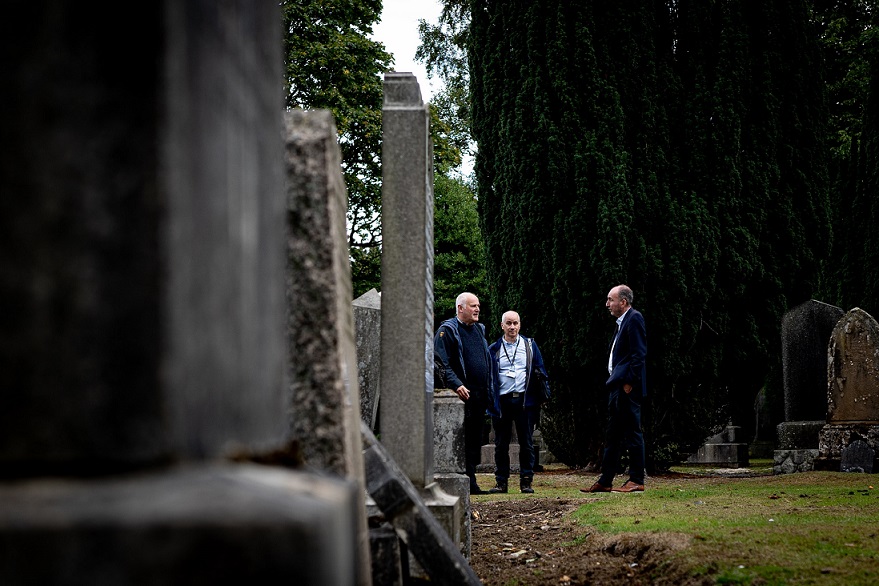
Pictured: Standing in the oldest section of Camelon Cemetery, which dates back to the 1870s, Ian (left), Allan (centre) and Kenneth (right) discuss the big issues facing Bereavement Services.
Family connection
Having heard about the challenges and the positive action being taken by the team to upgrade and modernise the service, Ian and Allan walked Kenneth to the grave of his great grandparents – the location of which was quickly found using PlotBox.
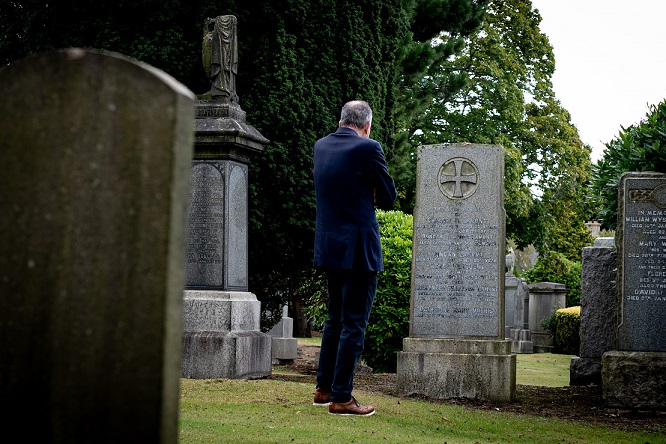
Pictured: A moment of quite reflection - Kenneth contemplates his family history in a green and leafy section of Camelon Cemetery.
Kenneth said: “I’ve wanted to find the final resting place of my great grandparents for some time but the opportunity to do so had never arisen, until now. Seeing first-hand how quickly the grave was found on PlotBox really highlighted the power of the tool and just one of the benefits it brings to both our organisation and individuals.”
He added: “Hearing how the team dealt with the pressure of the pandemic brought home the real difficulties front-line workers faced when severe restrictions came into play. Even in the darkest of hours their commitment and compassion never wavered. At all times, and regardless of their own personal worries, their focus remained firmly on supporting families that were unable to grieve or celebrate the life of a loved one as they would have wanted to. For that, and the vital work that they continue to do, I am extremely grateful.”
Before the article could be published, Gary Shield, Crematorium Technician sadly passed away. His colleagues asked that his quote remain as a lasting memory of his commitment to his job.